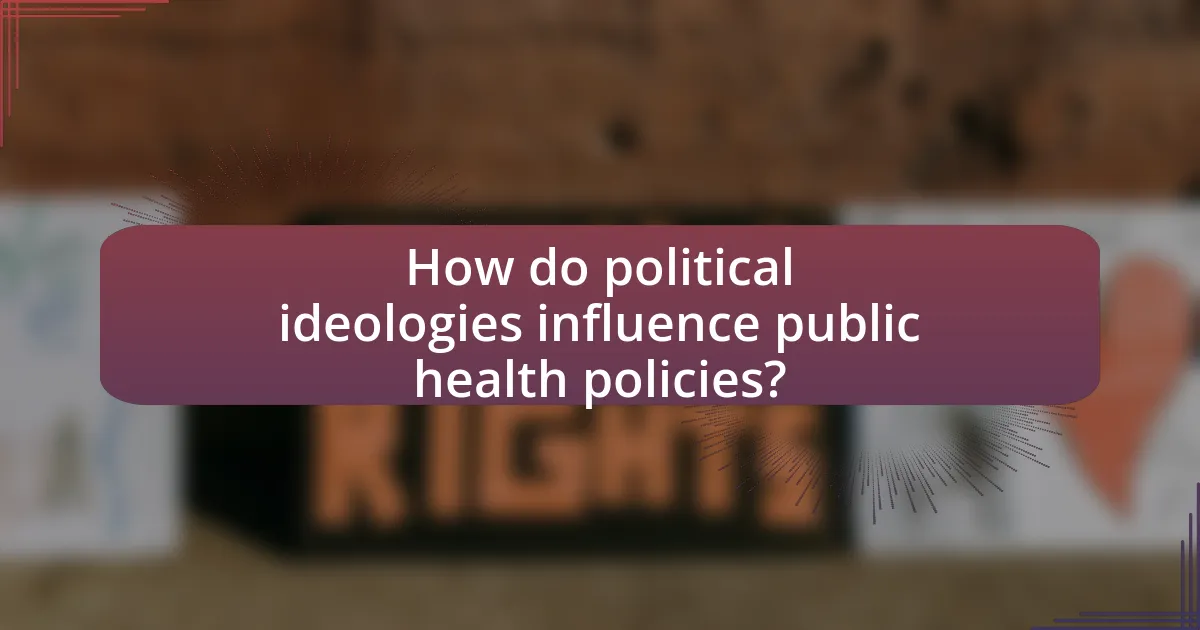Political ideologies play a crucial role in shaping public health policies by influencing priorities, funding, and approaches to healthcare. This article examines how liberalism, conservatism, socialism, and libertarianism impact public health initiatives, resource allocation, and health outcomes. It highlights the mechanisms through which these ideologies affect regulations, funding, and the creation of health-related laws, providing real-world examples from various countries. Additionally, the article discusses the implications of political ideologies on health equity and offers strategies for bridging ideological divides to enhance public health effectiveness.

How do political ideologies influence public health policies?
Political ideologies significantly influence public health policies by shaping the priorities, funding, and approaches to health care. For instance, liberal ideologies often advocate for universal health care and increased government intervention in health services, as seen in countries like Canada, where public health policies prioritize accessibility and equity. Conversely, conservative ideologies may emphasize personal responsibility and market-driven solutions, leading to policies that favor privatization and limited government involvement, as evidenced by the U.S. health care system, which relies heavily on private insurance. These ideological frameworks dictate not only the allocation of resources but also the framing of health issues, impacting legislation and public health outcomes.
What are the main political ideologies that shape public health policies?
The main political ideologies that shape public health policies are liberalism, conservatism, socialism, and libertarianism. Liberalism emphasizes government intervention to promote health equity and access to healthcare services, as seen in policies like the Affordable Care Act in the United States. Conservatism often prioritizes individual responsibility and limited government involvement, which can lead to reduced funding for public health initiatives. Socialism advocates for universal healthcare and public ownership of health services, exemplified by systems in countries like Sweden and the UK. Libertarianism promotes minimal government interference, advocating for personal choice in health decisions, which can result in less regulation of health markets. Each ideology influences the scope, funding, and implementation of public health policies in distinct ways.
How do liberal ideologies approach public health policy?
Liberal ideologies approach public health policy by emphasizing the role of government in ensuring equitable access to healthcare and promoting preventive measures. This perspective is rooted in the belief that health is a fundamental right and that systemic inequalities must be addressed through comprehensive public health initiatives. For instance, liberal policies often advocate for universal healthcare systems, increased funding for public health programs, and regulations aimed at reducing health disparities among different socioeconomic groups. Evidence of this approach can be seen in the implementation of the Affordable Care Act in the United States, which aimed to expand healthcare coverage and improve health outcomes for underserved populations.
What role do conservative ideologies play in shaping public health policy?
Conservative ideologies significantly influence public health policy by prioritizing individual responsibility, limited government intervention, and market-based solutions. These ideologies often advocate for personal choice in health-related decisions, leading to policies that emphasize personal accountability over government mandates. For instance, conservative-led states may resist federal health initiatives, such as the Affordable Care Act, arguing for state autonomy and reduced federal oversight. This approach can result in less funding for public health programs and a focus on private sector solutions, as seen in the promotion of health savings accounts and private insurance options. Additionally, conservative perspectives may shape public health messaging, emphasizing lifestyle choices and personal behavior as key determinants of health outcomes, which can affect funding and support for broader systemic health initiatives.
How do socialist ideologies impact public health policy?
Socialist ideologies significantly impact public health policy by prioritizing universal access to healthcare and emphasizing the role of the state in providing health services. In socialist systems, the government typically assumes responsibility for healthcare funding and delivery, aiming to eliminate disparities in access and outcomes. For instance, countries like Cuba and the United Kingdom have implemented healthcare systems that are publicly funded and managed, resulting in lower overall healthcare costs and improved health outcomes compared to privatized systems. Research indicates that these approaches can lead to higher life expectancy and lower infant mortality rates, demonstrating the effectiveness of socialist principles in shaping equitable health policies.
Why is understanding political ideologies important for public health?
Understanding political ideologies is crucial for public health because these ideologies directly influence health policies, funding, and the prioritization of health issues. For instance, a government with a liberal ideology may prioritize universal healthcare access and preventive services, while a conservative government might focus on market-driven solutions and personal responsibility in health. Research shows that political beliefs shape legislative agendas, impacting the allocation of resources for public health initiatives, as seen in the differing responses to the COVID-19 pandemic across various political administrations. Thus, comprehending these ideologies allows public health professionals to navigate policy landscapes effectively and advocate for health equity.
How do political ideologies affect health outcomes in populations?
Political ideologies significantly affect health outcomes in populations by influencing public health policies and resource allocation. For instance, countries with social democratic ideologies often prioritize universal healthcare access, leading to better health outcomes, as seen in Scandinavian nations where life expectancy is higher due to comprehensive health services. Conversely, neoliberal ideologies may promote privatization and reduced government intervention, resulting in disparities in health access and outcomes, as evidenced by the United States, where significant portions of the population lack adequate healthcare coverage. Research indicates that political decisions directly correlate with health metrics, such as infant mortality rates and chronic disease prevalence, highlighting the critical role of ideology in shaping health systems and ultimately affecting population health.
What are the implications of political ideologies on health equity?
Political ideologies significantly influence health equity by shaping public health policies and resource allocation. For instance, liberal ideologies often advocate for universal healthcare access, which can reduce disparities in health outcomes among different socioeconomic groups. In contrast, conservative ideologies may prioritize market-driven solutions, potentially leading to increased inequities as access to healthcare becomes dependent on individual financial means. Research indicates that countries with social democratic policies, such as those in Scandinavia, exhibit lower health disparities compared to those with more neoliberal approaches, highlighting the direct correlation between political ideology and health equity outcomes.

What are the mechanisms through which political ideologies affect public health policies?
Political ideologies affect public health policies through mechanisms such as framing, resource allocation, and regulatory approaches. Framing influences how health issues are perceived and prioritized; for example, conservative ideologies may emphasize personal responsibility in health, while liberal ideologies may advocate for systemic solutions. Resource allocation reflects ideological priorities, as seen in funding disparities for programs like universal healthcare versus privatized systems. Regulatory approaches vary, with ideologies shaping the extent of government intervention in health matters, such as tobacco control or vaccination mandates. These mechanisms demonstrate how political beliefs directly impact the formulation and implementation of public health policies.
How do political ideologies influence funding for public health initiatives?
Political ideologies significantly influence funding for public health initiatives by determining government priorities and resource allocation. For instance, conservative ideologies often emphasize limited government intervention and fiscal restraint, leading to reduced funding for public health programs, as seen in the 2017 U.S. budget proposal which aimed to cut funding for the Centers for Disease Control and Prevention by 17%. In contrast, liberal ideologies typically advocate for increased government spending on social services, resulting in enhanced funding for public health initiatives, exemplified by the Affordable Care Act, which expanded access to health services. These ideological frameworks shape legislative decisions, impacting the overall effectiveness and reach of public health initiatives.
What are the effects of political priorities on public health budgets?
Political priorities significantly influence public health budgets by determining funding allocations and resource distribution. For instance, when a government prioritizes preventive health measures, it may allocate more funds to vaccination programs and health education, leading to improved population health outcomes. Conversely, if political agendas focus on economic growth over health, budgets may be reduced for essential services like mental health or maternal care, resulting in negative health impacts. Historical data shows that during the COVID-19 pandemic, countries with strong political commitment to public health, such as New Zealand, were able to allocate substantial resources for testing and vaccination, leading to better health outcomes compared to nations with less focus on health, like the United States, which faced significant budget constraints in public health initiatives.
How do political ideologies shape the allocation of resources in health care?
Political ideologies significantly influence the allocation of resources in health care by determining priorities, funding levels, and access to services. For instance, liberal ideologies often advocate for universal health care and increased public funding, leading to broader access and equity in health services, as seen in countries like Canada where the government funds health care through taxation. Conversely, conservative ideologies typically emphasize market-driven solutions, resulting in limited government intervention and a focus on private health care options, which can create disparities in access, as evidenced by the U.S. health care system where millions remain uninsured. These ideological frameworks shape not only policy decisions but also the distribution of financial resources, ultimately affecting health outcomes across different populations.
In what ways do political ideologies affect public health regulations?
Political ideologies significantly influence public health regulations by shaping priorities, resource allocation, and the approach to health interventions. For instance, liberal ideologies often advocate for comprehensive public health measures, such as universal healthcare and preventive services, which can lead to regulations that promote access to care and address social determinants of health. In contrast, conservative ideologies may prioritize individual responsibility and limited government intervention, resulting in regulations that emphasize personal choice and market-based solutions, potentially limiting access to certain health services. Historical examples include the differing responses to the COVID-19 pandemic, where states led by liberal governors implemented stricter health mandates compared to those led by conservative governors, reflecting their ideological beliefs about government roles in public health.
How do ideologies influence the creation of health-related laws?
Ideologies significantly influence the creation of health-related laws by shaping the values and priorities that guide policy decisions. For instance, a liberal ideology may prioritize universal healthcare access, leading to laws that expand public health services, while a conservative ideology might emphasize personal responsibility and market-based solutions, resulting in laws that limit government intervention in healthcare. Historical examples include the Affordable Care Act, which reflects liberal values by aiming to increase healthcare access, and the repeal efforts that align with conservative ideologies focused on reducing government involvement. These ideological frameworks directly impact legislative agendas, funding allocations, and the overall direction of public health policy.
What is the impact of political ideologies on public health campaigns?
Political ideologies significantly influence public health campaigns by shaping priorities, messaging, and resource allocation. For instance, conservative ideologies often emphasize personal responsibility and limited government intervention, which can lead to campaigns that focus on individual health choices rather than systemic issues. In contrast, liberal ideologies typically advocate for broader government involvement in health care, resulting in campaigns that address social determinants of health and promote universal access to services. Evidence from the Affordable Care Act implementation in the United States illustrates this impact, where political support for expanded health coverage was largely driven by Democratic ideologies, leading to increased access to preventive services and health education initiatives.

What are the real-world examples of political ideologies shaping public health policies?
Real-world examples of political ideologies shaping public health policies include the implementation of universal healthcare in countries like Canada and the United Kingdom, which reflect social democratic values prioritizing equitable access to health services. In contrast, the United States’ healthcare system, influenced by neoliberal ideologies, emphasizes market-driven approaches, resulting in significant disparities in access and outcomes. Additionally, the response to the COVID-19 pandemic showcased varying ideological influences; countries with more authoritarian regimes, such as China, implemented strict lockdowns and surveillance measures, while liberal democracies like Sweden adopted a more hands-off approach, prioritizing individual freedoms over government intervention. These examples illustrate how political ideologies directly impact the formulation and execution of public health policies.
How have different countries implemented public health policies based on their political ideologies?
Countries have implemented public health policies in ways that reflect their political ideologies, with variations in approaches based on governance structures. For instance, socialist countries like Cuba prioritize universal healthcare access, resulting in a robust public health system that emphasizes preventive care and community health initiatives, evidenced by Cuba’s high doctor-to-population ratio and successful vaccination programs. In contrast, the United States, influenced by a more capitalist ideology, has a mixed healthcare system where public health policies often focus on market-driven solutions, leading to disparities in access and outcomes, as seen in the high uninsured rates compared to other developed nations. Additionally, Scandinavian countries, which embrace social democracy, implement comprehensive welfare policies that include extensive public health services, contributing to high life expectancy and low infant mortality rates, supported by their significant public health funding. These examples illustrate how political ideologies directly shape the structure and effectiveness of public health policies across different nations.
What lessons can be learned from the United States’ approach to public health?
The United States’ approach to public health teaches the importance of integrating political ideologies with health policy to effectively address public health challenges. For instance, the U.S. response to the COVID-19 pandemic highlighted how political divisions influenced public health messaging and compliance with health guidelines, resulting in varied vaccination rates across states. Research from the Kaiser Family Foundation indicates that political affiliation significantly affected individuals’ willingness to receive the vaccine, demonstrating that public health strategies must consider the political landscape to enhance effectiveness. Additionally, the U.S. experience underscores the necessity of federal and state collaboration, as seen in the varying success of health initiatives like Medicaid expansion, which was influenced by state-level political decisions.
How do Scandinavian countries exemplify socialist ideologies in public health?
Scandinavian countries exemplify socialist ideologies in public health through their commitment to universal healthcare systems funded by taxation. These nations, including Sweden, Norway, and Denmark, prioritize equitable access to healthcare services for all citizens, reflecting the socialist principle of collective welfare. For instance, Sweden’s healthcare system is primarily funded by taxes, ensuring that medical services are free at the point of use, which aligns with the socialist belief in reducing economic barriers to essential services. Additionally, Norway’s public health policies emphasize preventive care and health promotion, further demonstrating a collective approach to health that prioritizes community well-being over individual profit. This model has resulted in high health outcomes, with life expectancy in these countries averaging around 82 years, significantly higher than the global average, showcasing the effectiveness of socialist principles in enhancing public health.
What are the challenges faced when political ideologies clash with public health needs?
Political ideologies can significantly hinder public health initiatives when they conflict with scientific evidence and health needs. For instance, during the COVID-19 pandemic, political divisions led to inconsistent messaging about mask mandates and vaccination, resulting in lower compliance and increased transmission rates. Research from the American Journal of Public Health indicates that states with polarized political climates experienced higher COVID-19 case rates due to resistance against public health measures. This clash can also result in funding disparities, where ideologically driven policies prioritize certain health issues over others, neglecting critical areas like mental health or preventive care. Ultimately, these challenges create barriers to effective public health responses and can exacerbate health inequities within communities.
How do political conflicts hinder effective public health responses?
Political conflicts hinder effective public health responses by creating divisions that obstruct collaboration and resource allocation. For instance, during the Ebola outbreak in West Africa, political instability in affected countries delayed international aid and response efforts, leading to a higher mortality rate. Additionally, conflicting political agendas can result in inconsistent messaging about health measures, as seen in the COVID-19 pandemic, where partisan divides influenced public compliance with health guidelines. These factors demonstrate that political conflicts can severely disrupt the coordination necessary for timely and effective public health interventions.
What strategies can be employed to bridge ideological divides in public health policy?
To bridge ideological divides in public health policy, strategies such as fostering inclusive dialogue, utilizing evidence-based research, and promoting collaborative decision-making can be employed. Inclusive dialogue encourages stakeholders from diverse ideological backgrounds to share perspectives, which can lead to mutual understanding and compromise. Evidence-based research provides a common ground for discussions, as data-driven insights can help to align differing viewpoints on public health issues. Collaborative decision-making involves engaging various stakeholders, including policymakers, health professionals, and community members, in the policy formulation process, ensuring that multiple perspectives are considered and integrated. These strategies have been shown to enhance cooperation and reduce polarization in public health initiatives, as evidenced by successful public health campaigns that have effectively engaged diverse communities.
What best practices can be adopted to align political ideologies with effective public health policies?
To align political ideologies with effective public health policies, stakeholders should prioritize evidence-based policymaking that incorporates scientific research and data analysis. This approach ensures that health policies are grounded in factual information rather than ideological beliefs, leading to more effective outcomes. For instance, the World Health Organization emphasizes the importance of using data to inform health decisions, which can bridge gaps between differing political views by focusing on shared goals such as improving public health and reducing healthcare costs. Additionally, fostering bipartisan collaboration through inclusive dialogue and stakeholder engagement can help reconcile differing ideologies, as seen in successful public health initiatives like the Affordable Care Act, which combined elements from both conservative and liberal perspectives to expand healthcare access.





